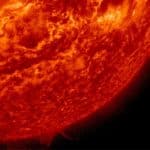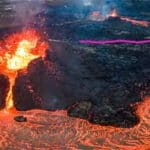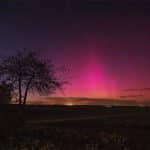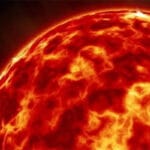In recent days, the Sun, which is ever approaching the peak of its activity, has sent towards Earth, not one, but several of these CMEs. Models estimate that at least three of them should hit our Earth on February 13, 2024.
Enough to trigger minor to moderate geomagnetic storms, class G1 to G2. With northern lights which should not become visible at very low latitudes.
Our Sun sometimes, when it erupts, expels kinds of plasma clouds. Astronomers call them coronal mass ejections (CMEs). In recent days, the Sun, which is ever approaching the peak of its activity, has sent towards Earth, not one, but several of these CMEs. Models estimate that at least three of them should hit our Earth on February 13, 2024.
A possibility of a strong solar storm caused by a coronal mass ejection
Enough to trigger minor to moderate geomagnetic storms, class G1 to G2. With northern lights which should not become visible at very low latitudes.
But the possibility remains for a rarer event to occur. Researchers speak of cannibalistic CME. Because not all coronal mass ejections move through space at the same speed. If one of those on its way to Earth were to be faster than the others, it could catch up with them. The combined power of these CMEs would then give rise to a strong solar storm, class G3. And potentially, the northern lights up to mid-latitudes.
A solar magnetic filament erupted on November 27 (~05:00 UT), carving a "canyon of fire" in the sun's atmosphere. The filament caused a coronal mass ejection (CME) into space.
Fortunately, most of the storm cloud will likely pass to the south of Earth.
However, a NASA model (shown below) suggests it will brush against our planet's magnetic field on November 30, potentially triggering a G1-class geomagnetic storm.
Since this first eruption, two more have been detected.
Iceland's geology is particularly changing at the moment. As the Fagradalsfjall volcano prepares for an imminent eruption, hundreds of earthquakes shake the Reykjanes Peninsula every day. Thanks to Northwestern University's Earthtunes app, it's possible to hear the creaks and rattles of the deep seismic forces currently acting beneath the island.
The latest collection of sounds was recorded last week, in early November 2023, by the Global Seismographic Network station (called BORG), located north-northeast of the capital Reykjavík.
This seismic activity usually cannot be heard by the human ear, but researchers transform seismic frequencies into audible pitches. It actually involves translating the sinuous lines of a seismometer into sound data.
“What you hear is 24 hours of seismic data, filled with earthquake signals. The vast majority of these earthquakes are associated with magma intrusion into the crust of the Fagradallsfjall-Svartsengi-Grindavik region of the Reykjanes Peninsula,” Suzan van der Lee, a seismologist at the university, said in a statement. Northwestern, which co-developed Earthtunes.
Iceland experiences intense volcanic and seismic activity because it is located on the Mid-Atlantic Ridge, where the North American and Eurasian plates are separating, allowing magma to rise from the mantle. It is also located at the top of a hot spot (that's the current scientific term) where the magma is particularly close to the surface.
Right now, the situation is particularly hot. On November 12, the Reykjanes Peninsula experienced a thousand earthquakes and many suspect an imminent volcanic eruption from Fagradalsfjall. The risk is so high that Icelandic authorities had the fishing town of Grindavík dug up after giant cracks formed along its roads.
“The activity is great, exciting and scary,” remarked Mr van der Lee.
After centuries of calm, eruptions on the Reykjanes Peninsula have resumed in 2021, ushering in a new era of intense seismic activity. It is likely that Iceland's southwestern peninsula now faces decades of volcanic instability.
UNUSUAL - It's a rare event, but it's starting to become a little less so. For the third time this year, the Northern Lights could be observed in France and other European countries on Sunday evening, November 5.
On social networks, users located in Auvergne, Alsace, the Alps, but also on the Côte d'Azur, shared photos of this moving nocturnal spectacle.
The phenomenon has also been observed in other countries, notably in Ukraine, Belgium, the Netherlands and the United Kingdom where magnificent colors could be observed above the Stonehenge site.
Caused by solar flares, the Northern Lights are rarer at lower latitudes, such as in France, where they are observable approximately every ten years, provided that the solar flare is strong enough and oriented in the right direction. If the countries of the Far North record up to several hundred per year, France has already seen them twice this year, in February and April.
Turbulent space weather in perspective.
Last month, astronomers closely tracked the evolution of sunspot AR3038, which went from "big to huge" in a matter of hours and grew to three times the size of Earth. With the Sun currently in an active phase of its 11-year cycle, activity on its surface keeps astronomers busy.


 The Sun is unleashed: several eruptions are heading towards the Earth
The Sun is unleashed: several eruptions are heading towards the Earth
 Solar flare, several CMEs heading towards Earth
Solar flare, several CMEs heading towards Earth
 Hear the angry roar of Iceland's intense seismic activity
Hear the angry roar of Iceland's intense seismic activity

